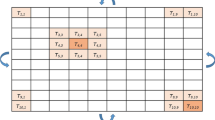Abstract
In this paper, we propose a framework for enabling for researchers of genetic algorithms (GAs) to easily develop GAs running on the Grid, named “Grid-Oriented Genetic algorithms (GOGAs)”, and actually “Gridify” a GA for estimating genetic networks, which is being developed by our group, in order to examine the usability of the proposed GOGA framework. We also evaluate the scalability of the “Gridified” GA by applying it to a five-gene genetic network estimation problem on a grid testbed constructed in our laboratory.
Similar content being viewed by others
References
Ando, S. and Iba, H., “Inference of Gene Regulatory Model by Genetic Algorithms,”Proc. CEC 2001, 2001.
BioGrid, http://www.biogrid.jp
Foster, I. and Kasseleman, C., “Globus: A Meracomputing Infrastructure Toolkit,”IJSA, 1997.
Goldberg, D. E., “Genetic Algorithms in Search, Optimazation and Machine Learning,”Addison-Wesley, 1989.
Gorges-Scheluter, M., “ASPARAGOS An Asynchronous Parallel Genetic Optimization Strategy,”Proc. 3rd ICGA, pp. 422–427, 1989.
Grimshaw, A. S., Wulf, W. A. and the Legion team, “The Legion Vision of World Wide Virtual Computer,”Communications of the ACM, 1997.
Hatakeyama, M., Kimura, S., Naka, T., Kawasaki, T., Yumoto, N., Ichikawa, M., Kim, J., Saito, K., Saeki, M., Sirouzu, M., Yokoyama, S. and Konogaya, A., “A Computational Model on the Modulation of MAPK and Akt Pathways in Heregulin-induced ErbB Signaling,” Journal of Biochemistry, 373, 2, pp. 451–463, 2003.
Hiroyasu, T., Miki, M., Hamasaki, M. and Tanimura, Y., “A New Model of Distributed Genetic Algorithm for Cluster Systems, Dual Individual DGA,”Proc. PDPTA ’2000, 1, pp. 477–483, 2000.
Konishi, F., Fukuzaki, A., Satou, K., Yamamoto, T., Defago, X. and Konagaya, A., “OBIGrid: A New Computing Platform for Bioinformatic,”Genome Informatics, 13, pp. 484–485, 2002.
Laszewski, G., Foster, I., Gawor, J., Smith, W. and Tuecke, S., “CoG Kits: A Bridge between Commodity Distributed Computing and High-Performance Grids,” inACM 2000 Java Grande Conf., pp. 97–106, 2000.
Lee, C., Park, K., Kim, J., “Hybrid Parallel Evolutinary Algorithms for Constrained Optimization Utilizing PC Clustering,”Proc. CEC 2001, 2, pp. 1436–1441, 2001.
Miyoshi, F., Nakayama, Y. and Tomita, M., “Estimation of Genetic Networks of the Circadian Rhythm in Cyanobacterium Using the E-Cell System,”Genome Informatics, 12, pp. 308–309, 2001.
Morishita, R., Imade, H., Ono, I., Ono, N. and Okamoto, M., “Finding Multiple Solutions Based on An Evolutionary Algorithms for Inference of Genetic Network by S-system,” to be published inProc. CEC 2003, 2003.
North Carolina Bioinformatics Grid, http://www.ncbiogrid.org.
Sakamoto, E., and Iba, H., “Inferring a System of Differential Equations for a Gene Regulatory Network by Using Genetic Programming,”Proc. CEC 2001, 2001.
Sato, H., Yamamura, M. and Kobayashi, S., “Minimal Generation Gap Model for Gas Considering both Exploration and Exploitation,”Proc. IIZUKA ’96, pp. 494–497, 1996.
Savageau, M. A., “Biochemical Systems Analysis: A Stuff of Function and Design in Molecular Biology,” Addison-Wesley, Reading, 1976.
Tanese, R., “Distributed Genetic Algorithms,”Proc. 3rd ICGA, pp. 434–439, 1989.
Tanimura, Y., Hiroyasu, T. Miki, M. and Aoi, K., “The System for Evolutionary Computing on the Computational Grid,”IASTED 14th Intl. Conf. on Parallel and Distributed Computing and Systems, pp. 39–44, 2002.
Tominaga, D., Koga, N. and Okamoto M., “Efficient Numerical Optimization Algorithm Based on Genetic Algorithm for Inverse Problem,”Proc. GECCO 2000, pp. 251–258, 2000.
Ueda, T., Koga, N., Ono, I. and Okamoto M., “Efficient Numerical Optimization Technique Based on a Real-coded Genetic Algorithm for Inverse Problem,”Proc. AROB ’02, 2002.
Author information
Authors and Affiliations
Additional information
Hiroaki Imade: He received his B.S. degree in the department of engineering from The University of Tokushima, Tokushima, Japan, in 2001. He received the M.S. degree in information systems from the Graduate School of Engineering, The University of Tokushima in 2003. He is now in Doctoral Course of Graduate School of Engineering, The University of Tokushima. His research interests include evolutionary computation. He currently researches a framework to easily develop the GOGA models which efficiently work on the grid.
Ryohei Morishita: He received his B.S. degree in the department of engineering from The University of Tokushima, Tokushima, Japan, in 2002. He is now in Master Course of Graduate School of Engineering, The University of Tokushima, Tokushima. His research interest is evolutionary computation. He currently researches GA for estimating genetic networks.
Isao Ono, Ph.D.: He received his B.S. degree from the Department of Control Engineering, Tokyo Institute of Technology, Tokyo, Japan, in 1994. He received Ph.D. of Engineering at Tokyo Institute of Technology, Yokohama, in 1997. He worked as a Research Fellow from 1997 to 1998 at Tokyo Institute of Technology, and at University of Tokushima, Tokushima, Japan, in 1998. He worked as a Lecturer from 1998 to 2001 at University of Tokushima. He is now Associate Professor at University of Tokushima. His research interests include evolutionary computation, scheduling, function optimization, optical design and bioinformatics. He is a member of JSAI, SCI, IPSJ and OSJ.
Norihiko Ono, Ph.D.: He received his B.S. M.S. and Ph.D. of Engineering in 1979, 1981 and 1986, respectively, from Tokyo Institute of Technology. From 1986 to 1989, he was Research Associate at Faculty of Engineering, Hiroshima University. From 1989 to 1997, he was an associate professor at Faculty of Engineering, University of Tokushima. He was promoted to Professor in the Department of Information Science and Intelligent Systems in 1997. His current research interests include learning in multi-agent systems, autonomous agents, reinforcement learning and evolutionary algorithms.
Masahiro Okamoto, Ph.D.: He is currently Professor of Graduate School of Systems Life Sciences, Kyushu University, Japan. He received his Ph.D. degree in Biochemistry from Kyushu University in 1981. His major research field is nonlinear numerical optimization and systems biology. His current research interests cover system identification of nonlinear complex systems by using evolutional computer algorithm of optimization, development of integrated simulator for analyzing nonlinear dynamics and design of fault-tolerant routing network by mimicking metabolic control system. He has more than 90 peer reviewed publications.
About this article
Cite this article
Imade, H., Morishita, R., Ono, I. et al. A grid-oriented genetic algorithm framework for bioinformatics. New Gener Comput 22, 177–186 (2004). https://doi.org/10.1007/BF03040956
Received:
Revised:
Issue Date:
DOI: https://doi.org/10.1007/BF03040956




